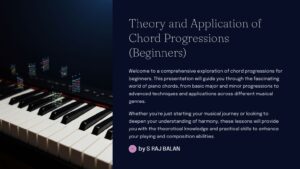
Chord Progressions for Beginners | 10 Best Tips
Chord progressions form the backbone of music, providing structure and emotional depth to melodies. Whether you are a beginner musician or an aspiring songwriter, understanding chord progressions will help you compose, improvise, and play songs with ease. In this guide, we will explore the theory behind chord progressions, their practical applications, and how you can start using them in your music. We will also include beginner-friendly videos to help you grasp these concepts visually. Full information is provided through 35 videos in this tutorial.
1. The Basics of Chord Progressions
Chord progressions are sequences of chords played in succession to create harmonic movement in music. The foundation of these progressions lies in the major and minor scales, which determine the chords available for a given key.
- What is a Chord? A chord is a combination of three or more notes played together. The most common types of chords are major, minor, diminished, and augmented.
- How Are Chords Built? Chords are built by stacking intervals of a third. For example, a C major chord consists of the notes C, E, and G.
- Understanding the I-IV-V-I Progression: One of the most widely used progressions in music is the I-IV-V-I (1-4-5-1) progression. In the key of C major, this translates to the chords C, F, G, and back to C.
A chord progression establishes the harmonic foundation of a song and dictates its emotional tone. While some progressions create a happy and uplifting feel, others convey sadness or tension. Mastering these progressions will help you develop a deeper understanding of how music works.

2. Common Chord Progressions and Their Emotions
Different chord progressions evoke different emotions in music. Here are some common progressions and their typical moods:
- The I-IV-V-I (C-F-G-C) Progression: This progression is often found in pop, rock, and folk music. It provides a strong sense of resolution and is easy to play.
- The I-V-vi-IV (C-G-Am-F) Progression: This is one of the most famous progressions used in modern music, found in songs like “Let It Be” by The Beatles and “Someone Like You” by Adele.
- The ii-V-I (Dm-G-C) Progression: Common in jazz, this progression creates a smooth and natural movement between chords.
The emotional impact of a chord progression depends on the combination of major and minor chords. For instance, a progression based on major chords tends to sound happy and triumphant, while a minor-based progression can feel melancholic or dramatic.
Understanding these progressions allows musicians to experiment with different styles and moods. By altering the order of chords or substituting them with variations, you can create unique musical pieces.
Beginner Video Tutorial: Playing Popular Chord Progressions
3. Practical Applications of Chord Progressions
Once you understand chord progressions, you can use them in various musical applications, such as songwriting, improvisation, and accompaniment.
- Songwriting: Chord progressions serve as the foundation for composing melodies and lyrics. Many hit songs follow simple progressions that are easy to learn and replicate.
- Improvisation: Musicians use chord progressions to improvise solos and harmonies. Knowing which scales work over specific progressions can help you create expressive melodies.
- Playing by Ear: Recognizing chord progressions allows musicians to play songs without sheet music, making it easier to jam with others.
To apply these progressions, practice transitioning between chords smoothly. Try playing along with different songs and noticing their harmonic structure. Over time, you will develop a natural sense of which progressions fit specific musical contexts.
Further Study Topics
- Understanding Seventh Chords and Their Uses
- How to Create Your Own Chord Progressions
- The Role of Chord Inversions in Music
- Advanced Jazz and Blues Progressions
- How to Modulate Between Keys Using Chord Progressions
Related Topics
- Music Theory Basics
- How to Read Chord Symbols
- The Importance of Rhythm in Chord Progressions
- Playing Piano or Guitar with Chord Progressions
- The Influence of Chord Progressions in Different Genres
By mastering chord progressions, you unlock the ability to create and understand music on a deeper level. Start practicing with the examples provided and watch the video tutorials for hands-on learning!
Enjoy your learning.
S RAJ BALAN
www.bollytnes.com

